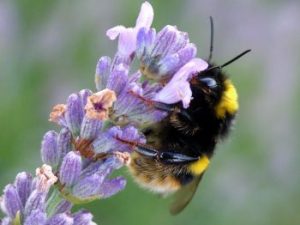Why plant diversity is so important for bee diversity
by Stephanie Allen, University of Sussex
2/10/2021

A bumble bee foraging on lavender. Photo taken by Prof Francis Ratnieks. Photo courtesy of the University of Sussex.
As abundant and widespread bees, it is common to see both bumble bees and honey bees foraging on the same flower species during the summer, whether in Britain or many other countries.
Yet researchers at the Laboratory of Apiculture and Social Insects (LASI), at the University of Sussex, show that these two different bees dominate on different flower species and have found out why.
By studying 22 flower species in southern England and analysing the behaviour of more than 1,000 bees, they found that ‘energy efficiency’ is a key factor when it comes to mediating competition.
Bee bodyweight and the rate at which a bee visits flowers determine how energy efficient they are when foraging. Bodyweight determines the energy used while flying and walking between flowers, with a bee that is twice as heavy using twice as much energy. The rate at which a bee visits flowers, the number of flowers per minute, determines how much nectar, and therefore energy, it collects. Together, the ratio of these factors determines bee foraging energy efficiency.
Read more here: https://www.sussex.ac.uk/news/research?id=54641
Read the Ecology paper: https://esajournals.onlinelibrary.wiley.com/doi/abs/10.1002/ecy.3285?af=R